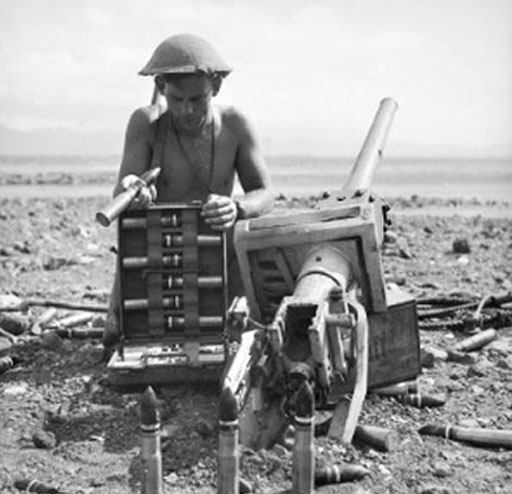Air Operations, Aleutians
While 7 28th Composite Bomb Group B-24s attack the seaplane base at Kiska, P-39s of the 54th Fighter Group's 42nd Fighter Squadron down 4 A6M2-N 'Rufe' fighter-bombers over Kiska about 1040 hours.
[Air Operations, Europe
BOMBER COMMANDDaylight Ops:
- 3 Mosquitos sent out; 2 attack a chemical works at Sluiskil and an oil depot at Ghent.
- No losses.
- 78 Lancaster of 5 Group attack Wismar; bombing is scattered.
- 2 planes are lost.
- 27 Halifaxes of 4 Group are sent to Flensburg; 12 crews claim good bombing results.
- 12 aircraft are lost.
- 25 Stirlings of 3 Group attack Lübeck; bombing here is scattered also.
- 3 planes are lost.
Air Operations, Greece
USAMEAF B-24s attack Axis ships in Pylos Bay and claim hits on a large vessel.
[Air Operations, New Guinea
5th Air Force B-17s and P-40s attack Japanese Army forces at 5 locations in the Owen Stanley Mountains.
[Eastern Front
Army Group A, charged with the task of conquering the Caucasus with its rich oilfields, is halted by Russian resistance. The impetus of the German thrust is becoming exhausted. There is heavy fighting along the Black Sea coast between Novorossiysk and Tuapse. Inland the Germans are still battling toward Grozny. Bloody fighting continues in Stalingrad, where the German 6th Army pays dearly for every yard of ground gained. The Russians try in vain to bring help to the ruined city. There are German gains in the Orlovka sector of Stalingrad. Heavy losses in men and material, shortage of supplies, especially fuel, and the nature of the terrain are beginning to tell on the armies of the Reich.
NORTHERN SECTORThe Germans complete the destruction of thw 2nd Shock Army encircled in the Gaitolovo pocket.
SOUTHERN SECTORGerman pincers close at Orlovka, trapping a battalion of he 115th Rifle Brigade. Two other brigade battalions attempt a relief attack from the east but are pinned down by massive German artillery fire and air strikes. Under intense fire, the isolated battaion continues to hold for another week in teh Orlovka gully.
In the factories district, the Germans hammer at the Soviet defenses. Heavy attacks strike the 193rd Rifle Division before the Red October factor throughout the day, the 284th Rifle and 13th Guards are also being hard pressed as the Germans try to push on to the Volga. German efforts to reach the river through the Krutoy and Dolgi gullies fail as the 13th Guards wipe out the attackers. During the night the 295th Infantry Division sends an assault force of 300 men into the Krutoy Gully and onto the banks of the Volga. Once they reach the river, the group turns south, into the rear of the 13th Guards, and then wait for dawn when they will attack from both front and rear.
As his defenses crumble, Chuikov orders the 39th Guards Div to fortify and hold the Red October workshops.
The fighting in Stalingrad cost both sides dear. Since September 13 Paulus has suffered 40,000 casualties, while the 62nd Army has lost 78,000 men. The Soviets, however, are constantly reinforced, maintaining a combat strength of around 55,000 men. Inside the city, the Soviets have 950 artillery pieces, 500 mortars and 80 tanks.
SOVIET COMMANDThe Stavka disbands the 4th Tank Army, absorbing the remnants into the 65th Army. The XVII and XVIII Tank Corps are pulled out of the Voronezh sector and moved behind the Don Front to refit, together with the 3rd and 5th Tank Armies, which go into Stavka reserve. The IV Tank Corps, already with the Don Front, is also pulled out of the line to refit.
[New Guinea
Gen MacArthur issues orders for the Allied advance on Gona and Buna. Australian forces have already begun to move forward along the Kokoda Trail. A US force is to move over the parallel Kapa Kapa Trail to join the Australians in cutting off the Japanese retreat at the Kumusi River. There are also to be landings along the north coast between Milne Bay and Cape Nelson, especially at Wanigela.
Type 95 Ha Go Main Gun |
 |
Pacific
- The Lisbon Maru (7053t), carrying 1,816 British and Canadian PoWs and 2,000 Japanese troops from Hong Kong to Japan, is torpedoed by the US submarine Grouper (SS-214). Guards batten down the hatches to prevent PoWs from leaving the crippled vessel, while the crew and troops are taken off. The ship sinks on October 2. 840 PoWs are lost. Many of thoses who manage to escape are machine-gunned on the surface. Japanese prison ships did not display the red cross to signify prisoners on board, and conditions were so horrifying that more than 22,000 Allied PoWs died on Japanese ships during the war.
- The US submarine Kingfish (SS-234) torpedoes and sinks the Japanese merchant cargo ship Yomei Maru (2860t) off Ichiezaki, Jaapan.
- The Japanese merchant cargo ship Tosei Maru (2814t) is sunk by the US submarine Nautilus (SS-168) east of Shiriyazaki, Japan.
- The US submarine Sturgeon (SS-187) damages the Japanese aircraft transport Katsuragi Maru (8033t) off Cape St George, New Ireland.
Japanese Troop Transport Lisbon Maru |
 |
United States, Home Front
Gasoline is now rationed in most parts of the country.
[